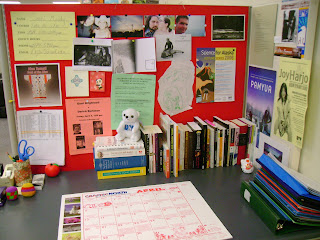Magazines about MFA programs urged me to consider TAships carefully. "Do you really want to spend your graduate career teaching instead of writing?" In the end, I decided that I wanted to take as few student loans as possible, and a TAship was the only way.
What I did not realize when I started teaching at UAF was that learning how to teach would become an invaluable part of my education. I believe that being a teacher made me a better student in my graduate classes, and helped me to grow socially.
It was a small space, but I was surrounded by fellow first-years. If I was having problems teaching or writing a story, there were always people around to offer support and advice.
"How is your class going?"
"What do you think about Who Slashed Celanire's Throat?"
To have people who not only ask you how you are doing, but who are genuinely interested in the answer and will talk with you for twenty minutes until you feel better - I would have missed out on all of this if I had not been a TA. I would not have had a desk, a space where I could work and talk and run into my fellow grad students.
At the beginning of my 2nd year, I moved to a much larger office space that had been given up by a 3rd year student after he graduated. I had my own bookcase, a filing cabinet, lots of wall space, and a coat rack that I misguidedly covered in blazers.
The best aspect of my 2nd and 3rd year TA space was that it was good for hanging out. Sure, I had much more desk space on which to sort and grade papers, and I could roll my desk chair back and forth without worrying about knocking into anyone. But for the first time I had a cozy guest chair that was also out of the line of traffic.
My MFA friends stopped by to play with the dinosaur that made silly roaring sounds when you pushed a button, or to borrow a book to teach in class. We talked about the stories we wrote, the literature classes we took, the students we taught.
Before I left UAF, I had to clean out my desk space. What I couldn't keep I gave away, leaving a plant on one friend's desk, a plastic Gloomy bear on another. I turned in my keys to to the Writing Center and the 8th floor to Leah, the wonderful administrative organizer for the English department. Turning in those keys felt like losing the last link to all of the wonderful friendships I'd gained during my MFA program.
"Don't worry," Leah said. "You'll have new keys soon."
"The Internet is our new Writing Center. We can hangout anytime," another MFA friend said.
But as wonderful as the Internet is, as lonely as I would be without it, I still miss the experience of having a physical space amid a community of writers. These last two, long years since I left UAF I've been working on my thesis at my small desk in the corner of my bedroom. There isn't another chair in the room, just an Internet window open, hoping someone drops by.
All TAs are offered desk space on the English department floor. The desks are out in the open, somewhat divided by office partitions.
My first year as a TA and as a graduate student, I had a small desk with the right side pushed up against the wall. There wasn't much space, but I was ecstatic to have it.
 |
| First year TA desk at UAF |
"How is your class going?"
"What do you think about Who Slashed Celanire's Throat?"
To have people who not only ask you how you are doing, but who are genuinely interested in the answer and will talk with you for twenty minutes until you feel better - I would have missed out on all of this if I had not been a TA. I would not have had a desk, a space where I could work and talk and run into my fellow grad students.
At the beginning of my 2nd year, I moved to a much larger office space that had been given up by a 3rd year student after he graduated. I had my own bookcase, a filing cabinet, lots of wall space, and a coat rack that I misguidedly covered in blazers.
 |
| 2nd & 3rd year desk |
The best aspect of my 2nd and 3rd year TA space was that it was good for hanging out. Sure, I had much more desk space on which to sort and grade papers, and I could roll my desk chair back and forth without worrying about knocking into anyone. But for the first time I had a cozy guest chair that was also out of the line of traffic.
My MFA friends stopped by to play with the dinosaur that made silly roaring sounds when you pushed a button, or to borrow a book to teach in class. We talked about the stories we wrote, the literature classes we took, the students we taught.
 |
| View from a visitor's seat |
"Don't worry," Leah said. "You'll have new keys soon."
"The Internet is our new Writing Center. We can hangout anytime," another MFA friend said.
But as wonderful as the Internet is, as lonely as I would be without it, I still miss the experience of having a physical space amid a community of writers. These last two, long years since I left UAF I've been working on my thesis at my small desk in the corner of my bedroom. There isn't another chair in the room, just an Internet window open, hoping someone drops by.








